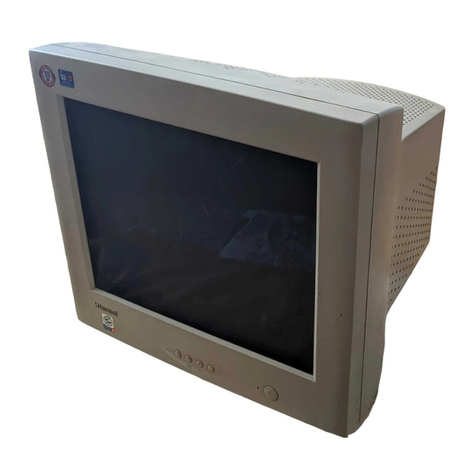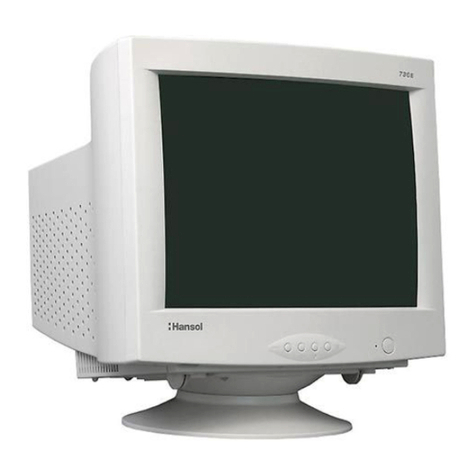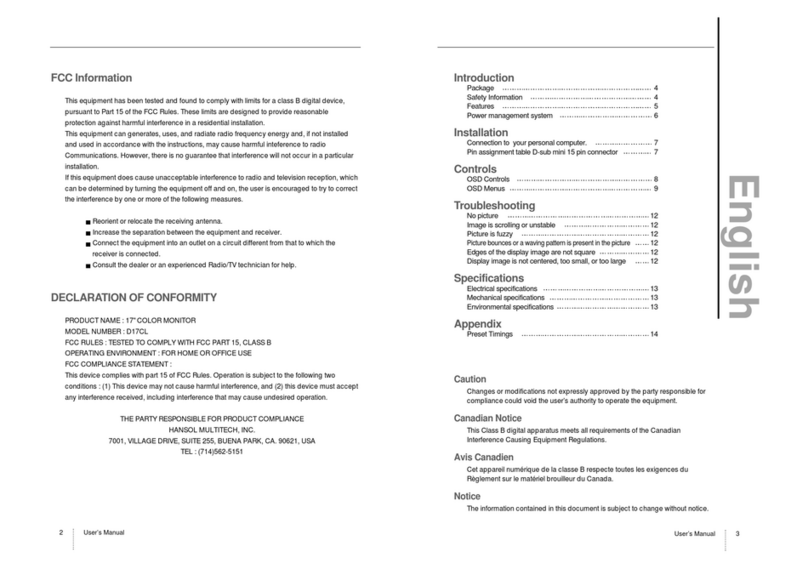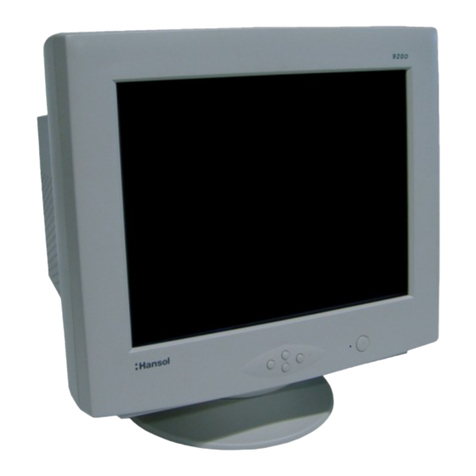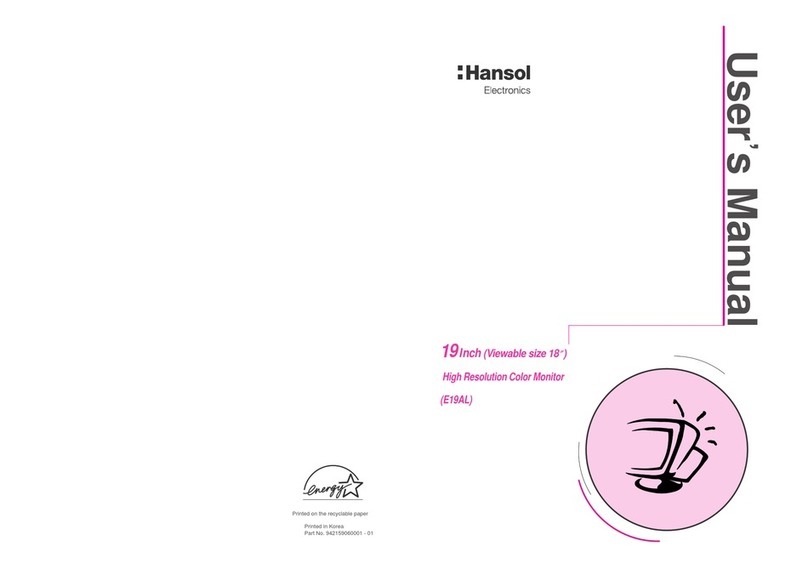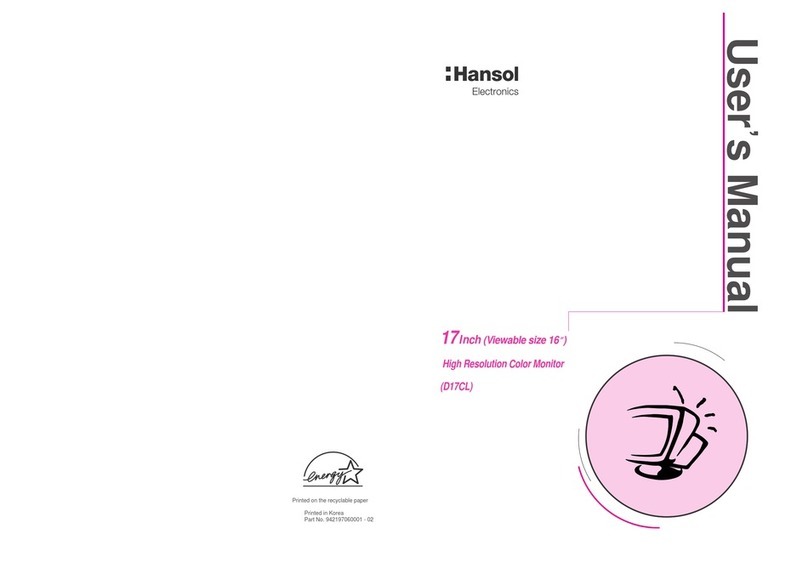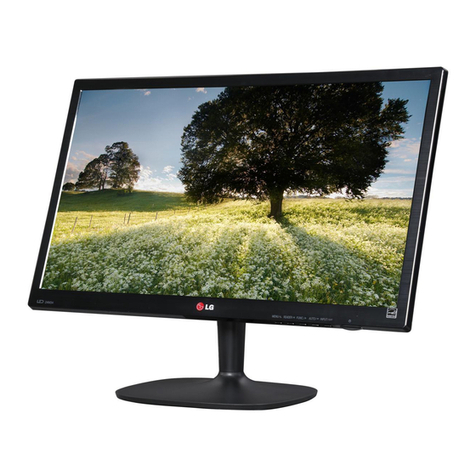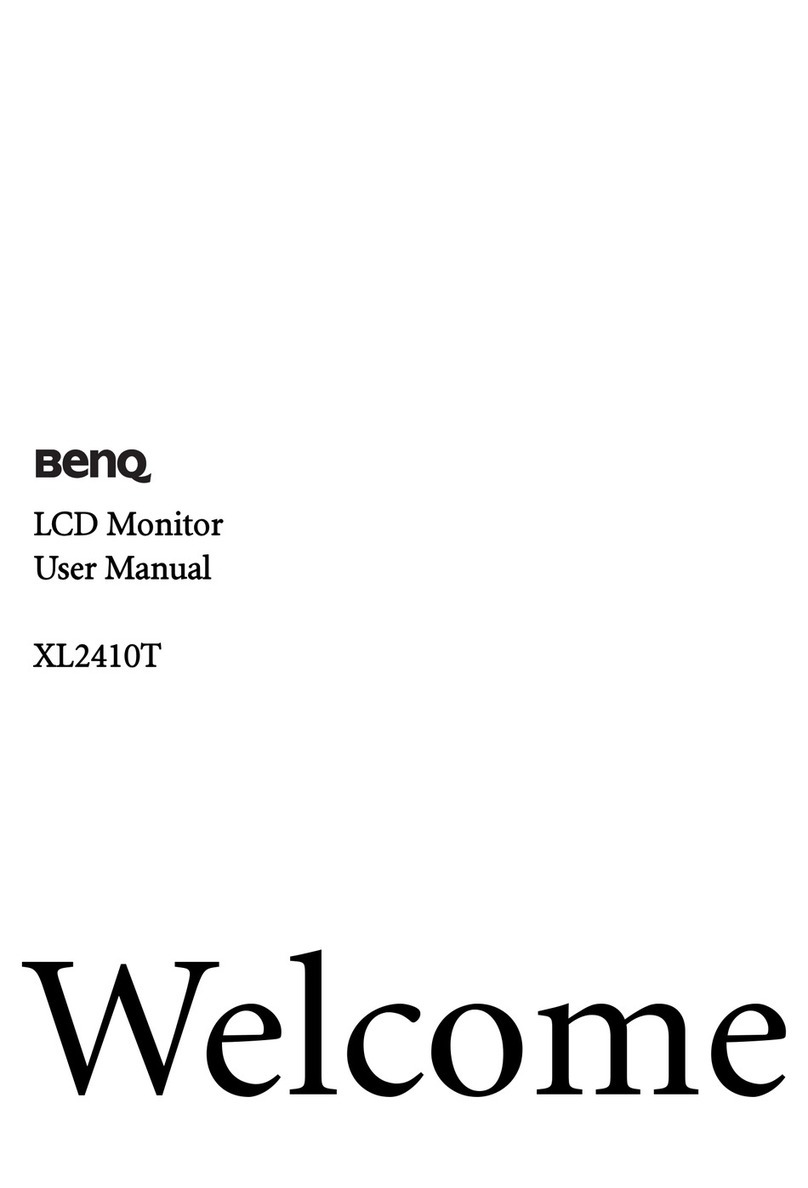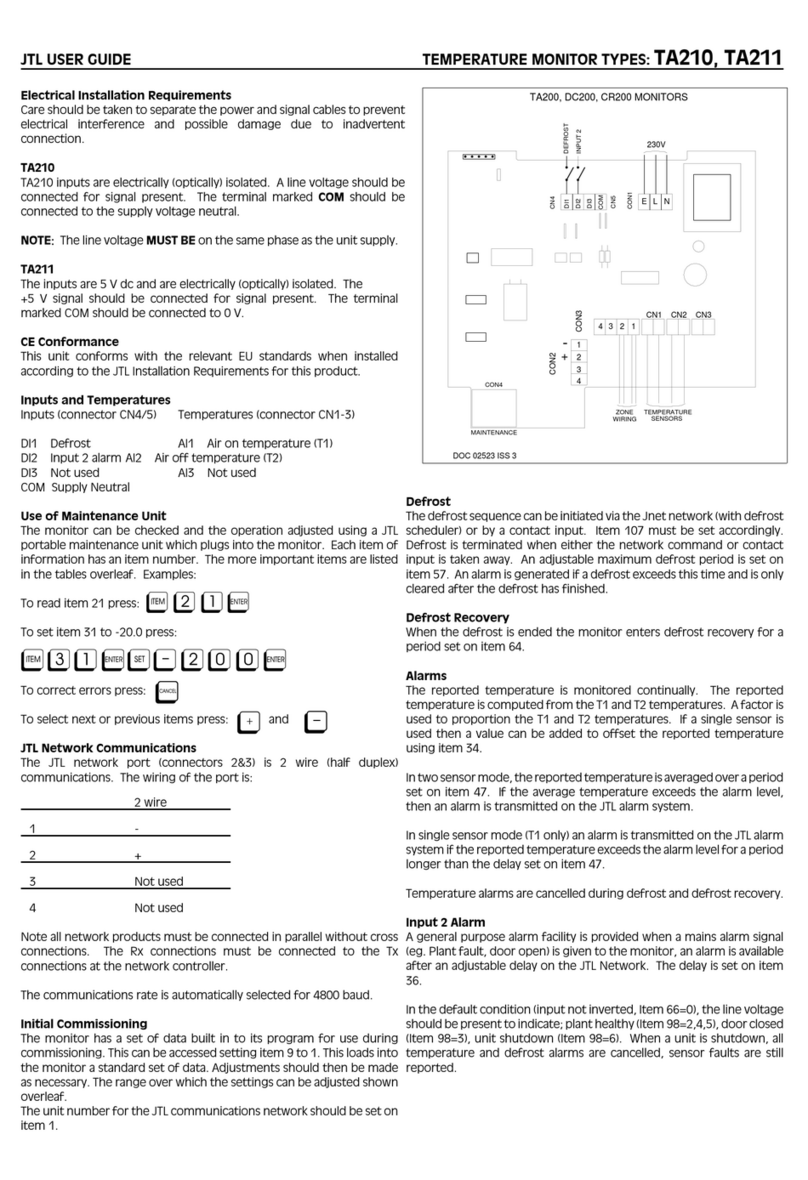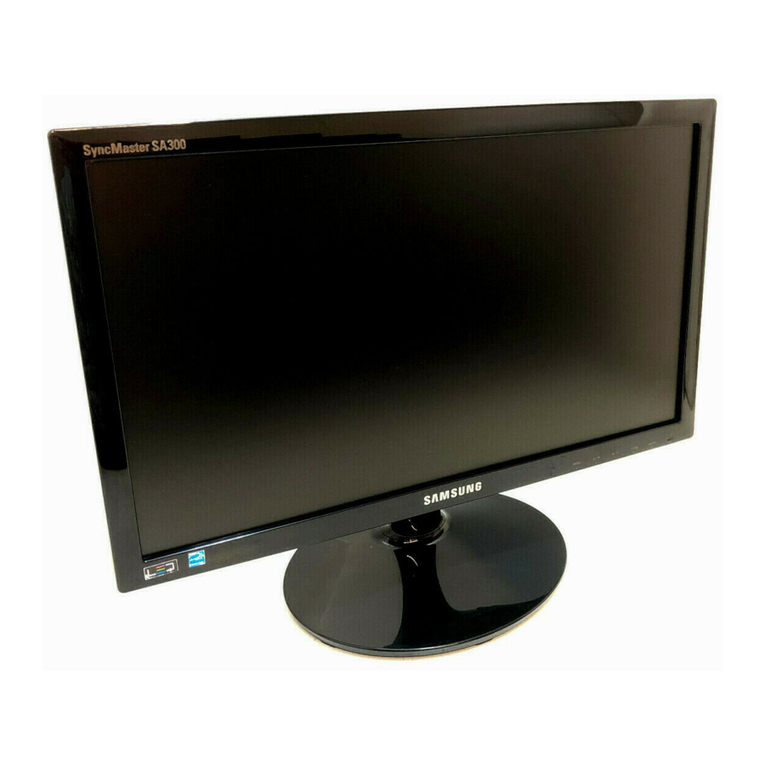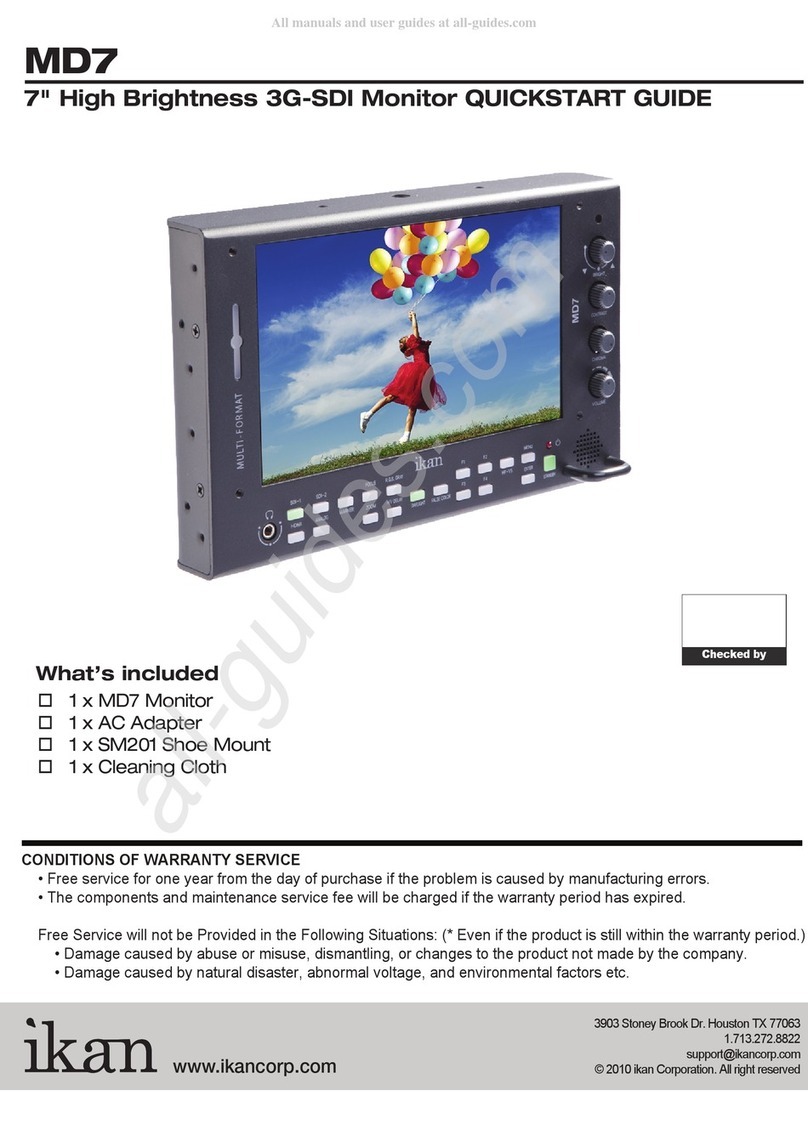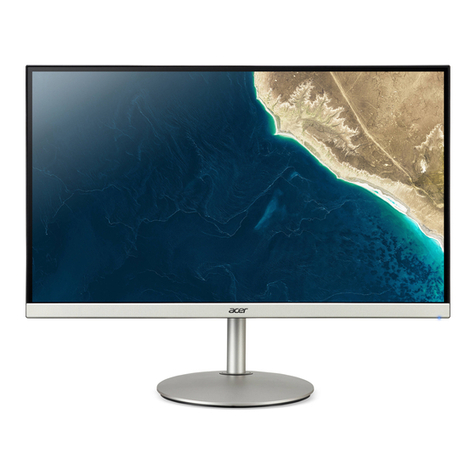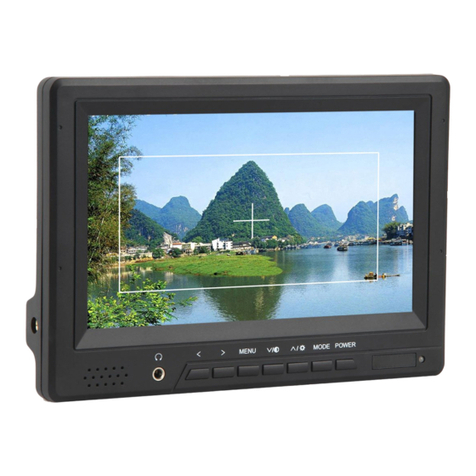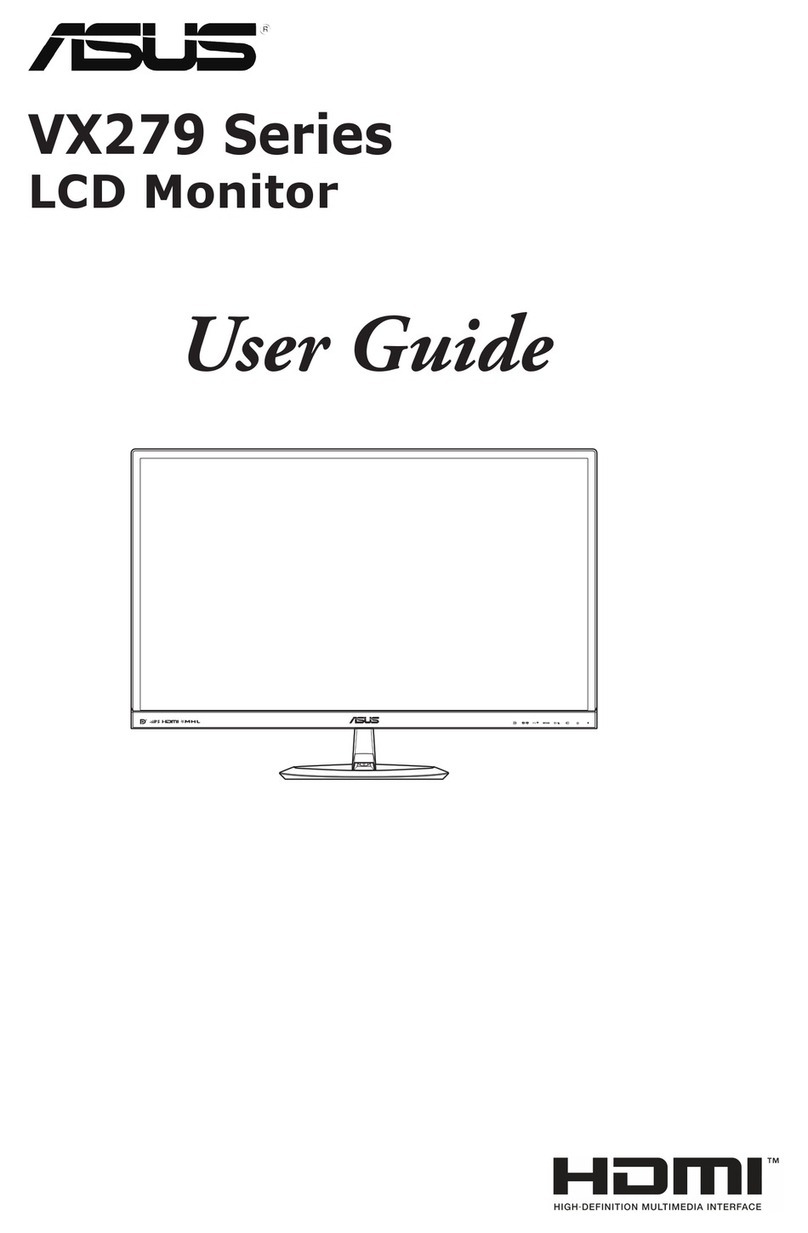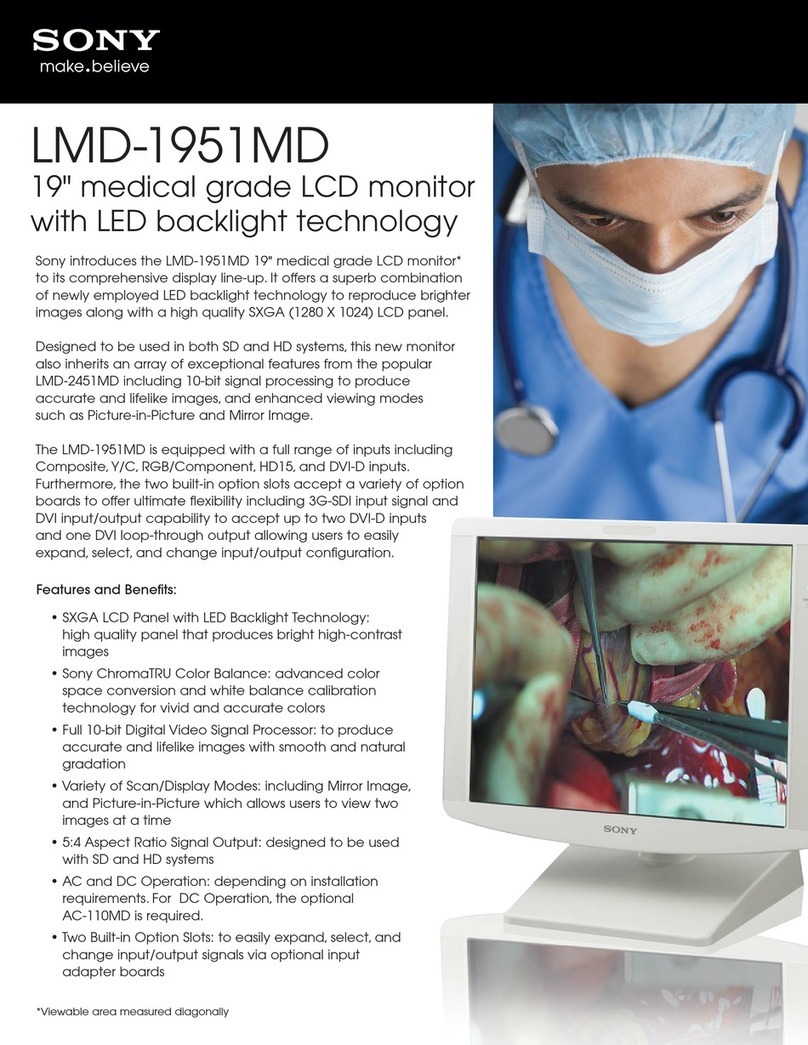Hansol H950VI B19BF User manual

Service Manual
19Inch (Viewable size 19.0 )
TFT LCD Analogue Color Monitor
H950VI (B19BF)

Contents
1. Precautions
Safety Precautions 4
Servicing Precautions 6
Electrostatically Sensitive Devices (ESD) Precautions 7
2. Product Specifications
Specifications 8
Pin Assignment Table D-Sub 15 Pin Connector 9
Timing Chart 9
Dimensions 10
3. Disassembly and Reassembly
11
4. Troubleshooting
14
5. Exploded View & Parts List
17
6. Packing & Unpacking
19
7. Electrical Parts List
Main Board 20
Combo Board 22
OSD Control Board 24
Panel 25
Service Manual
2

CONTENTS
Contents
3
Service Manual
8. Block Diagram
26
9. Wiring diagram
27
10. PCB Layout
Main PCB 28
Key PCB 29
Combo board PCB 30
Semiconductor Aead Identification 32
11. Schematic Diagram
34
Copyright
2003 by Hansol LCD Inc.
All rights reserved.
This manual may not, in whole or in part, be copied,
photocopied, reproduced, translated, or converted to any
electronic or machine readable form without prior written
permission of Hansol
Electronics Inc.
H950VI(B19BF)Service Manual
First editior September 2003

Service Manual
4
Precautions
1. Precautions
Follow these safety, servicing and ESD precautions to prevent damage and to protect against
potential hazards such as electrical shock.
1-1 Safety Precautions
1-1-1 Warnings
1. For continued safety, do not attempt to modify the circuit board.
2. Disconnect the AC power ,Signal cable and Stereo cable before servicing.
1-1-2 Servicing the LCD Monitor
1. When servicing the LCD Monitor Disconnect the AC power cord from the AC outlet.
2. It is essential that service technicians have an accurate voltage meter available at all times.
Check the calibration of this meter periodically.
1-1-3 Fire and Shock Hazard
Before returning the monitor to the user,perform the following safety checks :
1. Inspect each lead dress to make certain that the leads are not pinched or that hardware is not
lodged between the chassis and other metal parts in the monitor.
2. Inspect all protective devices such as nonmetallic control knobs, insulating materials, cabinet
backs, adjustment and compartment covers or shields, isolation resistor-capacitor networks,
mechanical insulators, etc.
3. To be sure that no shock hazard exists, check for leakage current in the following manner.
Warning : Do not use an isolation transformer during this test.
a. Plug the AC line cord directly into a 120 Volt AC outlet.
b. Unisg two clip leads, connect 1.5 , 10 watt resistor paralleled by a 0.15 capacitor in series
with an exposed metal cabinet part and a known earth ground, such as an electrical conduit or
electrical ground connected to an earth ground.

5
Service Manual
PRECAUTION
Precautions
c. Use a SSVM or VOM with 1000 ohms per-volt or higher sensitivity to measure the AC voltage
drop across the resistor (see Figure 1-1).
d. Connect the resistor to an exposed metal part having a return path to the chassis(metal cabinet,
screw heads, knobs, shafts, escutcheon, etc.) and measure the AC voltage drop across the
resistor.
e. Any reading of 5.25 Volt RMS ( this corresponds to 3.5 milliampere AC ) or more is excessive
and indicates a potential shock hazard. Correct the shock hazard before returning the monitor to
the user.
1-1-4 Product Safety Notices
Some electrical and mechanical parts have special safety-related characteristics which are often not
evident from visual inspection. The protection they give may not be obtained by replacement that
does not have the same safety characteristics as the recommended replacement part may create
shock, fire and /or other hazards. Product safety is under review continuously and new instructions
are issued whenever appropriate.
AC Voltmter
1500
0.15
Test Probe
To Exposed
Metal Parts To Known
Earth Ground Figure 1-1.
Leakage Current Test Circut

Service Manual
6
Precautions
1-2 Servicing Precautions
WARNING : An electrolytic capacitor installed with the wrong polarity might explode.
Caution : Before servicing instruments covered by this service manual and its supplements,
read and follow the Safety Precautions section of this manual.
Note : If unforeseen circumstances create conflict between the following servicing preautions
and any of the safety precautions, always follow the safety precautions.
1-2-1. General Servicing Precautions
1. Servicing precautions are printed on the cabinet, and should be followed closely.
2. Always unplug the unit's AC power cord from the AC power source before attempting to :
(a) remove or reinstall any component or assembly, (b) disconnect PCB plugs or connectors,
(c) connect a test component in paralled with an electrolytic capacitor.
3. Some components are raised above the printed circuit board for safety. An insulation tube or tape
is sometimes used. The internal wiring is sometimes clamped to prevent contact with thermally hot
components. Reinstall all such elements to their original position.
4. After servicing, always check that the screws, components and wiring have been correctly
reinstalled. Make sure that the portion around the serviced part has not been damaged.
5. Check the insulation between the blades of the AC plug and accessible conductive parts
(examples; metal panels, input terminals and earphone jacks)
6. Insulation Checking Procedure : Disconnect the power cord from the AC source and turn the power
switch ON. Connect an insulation resistance meter(500V) to the blades of the AC plug.
The insulation resistance between each blade of the AC plug and accessible conductive parts
(see above) should be greater than 1 megohm.
7. Always connect a test instrument's ground lead to the instrument chassis ground before connecting
the positive lead; always remove the instrument's ground lead last.

7
Service Manual
PRECAUTIONS
Precautions
1-3 Electrostatically Sensitive Devices(ESD) Precautions
Some semiconductor (solid state) devices can be easily damaged by static electricity. such
components are commonly called Electrostatically Sensitive Devices(ESD). Examples of typical ESD
devices are integrated circuits and some field-effect transistors. The following techniques will reduce
the incidence of component damage caused by static electricity.
1. Immediately before handling any semiconductor components or assemblies, drain the electrostatic
charge from your body by touching a known earth ground. Alternatively, wear a discharging
wrist strap device. To avoid a shock hazard, be sure to remove the wrist strap before applying
power to the monitor.
2. After removing an ESD-equipped assembly, place it on a conductive surface such as aluminum foil
to prevent accumulation of an electrostatic charge.
3. Do not use freon-propelled chemicals. These can generate electrical charges Sufficient to damage
ESDs.
4. Use only a ground-tip soldering iron to solder ESDs.
5. Use only an anti-static solder removal device. Some solder removal devices not classified as "anti-
static" can generate electrical charges sufficient to damage ESDs.
6. Do not remove a replacement ESD from its protective package until you are ready to install it. Most
relacement ESDs are packaged with leads that are electrically shorted together by conductive
foam, aluminum foid or other conductive materials.
7. Immediately before removing the protective material from the leads of a replacement ESD, touch
the protective material to the chassis or circuit assembly into which the device will be installed.
Caution : Be sure no power is applied to the chassis or circuit and observe all other safety
precautions.
8. Minimize body motions when handling unpackaged replacement ESDs. Motions such as brushing
clothes together, or lifting your font from a carpeted floor can generate enough static electricity to
damage an ESD.

Service Manual
8
Precautions
2. Product Specifications
2-1 Specifications
LCD PANEL
Synchornization
Video Input
Power
Consumption
Control Keys
Input Power
Wall Mount
Safety & EMI
Dimension
Model
Type
Screen Size
Maximum Resolution
Pixel Range
Display Colors
Contrast Rate
Viewing Angle
Response Speed
Brightness
Horizontal Frequency
Vertical Frequency
Video Signal
Synchronous Signal Mode
Maximum
Soft Power Off
Front part
Safety Standard
EMI
Low Radiation
Size and Weight
H950VI (B19BF)
Amorphous Active Matrix Super TFT LCD (LTM 190E1 - L01)
376.32(H) X 301.056(V) mm (19 inch diagonal)
1280 X 1024 @ 75Hz
0.294mm X 0.294mm
8 bit data =16.7 million colours
500 : 1
85°/85°/85°/85°( up /down /left / right)
25ms
250 cd/m2
80KHz( Max )
76HZ( Max )
Analog RGB(0 - 850 mV max) 75 ohm
LVDS (8bit) 3 sync signal, Clock
45W
Under 1W
SOURCE,MENU/MUTE,AUTO/SELECT,POWER,
BRIGHTNESS/-,CONTRAST/+,VOL/MUTE
100 / 240V(50~60Hz)
VESA Standard
UL,CE,CB,TUV
FCC,RRL
MPR-II
452 X 216X 416 / 6.7Kg

9
Service Manual
PRODUCT SPECIFICATIONS
Product Specifications
2-3 Timing chart
This section of the service manual describes the timing that the computer industry recognizes as
standard for computer-generated video signals.
2-2 Pin Assignment
The 15-pin D-sub connector(male) of the Analog signal cable
The 24 pin DVI-D cable Pin Connection
15
610
11 15
No.
1
2
3
4
5
6
7
8
9
10
11
12
Display Mode
VGA (720 X 400)
VGA (640 X 480)
VGA (640 X 480)
SVGA (800 X 600)
SVGA (800 X 600)
XGA (1024 X 768)
XGA (1024 X 768)
SXGA (1280 X 1024)
SXGA (1280 X 1024)
MAC (640 X 480)
MAC (832 X 624)
MAC (1152 X 870)
Hor. Freq (kHz)
31.469
31.469
37.500
37.900
46.875
48.363
60.023
63.981
79.976
35.000
49.726
68.681
Ver. Freq (Hz)
70.087
59.940
75.000
60.320
75.000
60.004
75.029
60.020
75.025
66.667
74.551
75.062
Dot Clock (MHz)
28.322
25.175
31.500
40.000
49.500
65.000
78.750
108.000
135.000
30.240
57.284
100.000
Pin Signal Pin Signal Pin Signal
18
D1
D2
17 24 D3 D4
9
Pin No. Assignment Pin No. Assignment
1 Red Video 9 5V Input
2 Green Video 10 ST_DET
3 Blue Video 11 Ground
4 F Ground 12 SDA
5 N.C 13 H.Sync
6 Red Video Ground 14 V.Sync
7 Green Video Ground 15 SCL
8 Blue Video Ground

Service Manual
10
Product Specifications
2-4 Dimensions
418
344
437.2
FRONT VIEW SIDE VIEW
REAR VIEW

Disassembly and Reassembly
11
Service Manual
DISASSEMBLY AND REASSEMBLY
3. Disassembly and Reassembly
The section of the service manual describes the disassembly and reassembly procedure for
H950VI.
WARNING : This has to be disassembled and reassembled carefully because TFT-LCD Panel
is weak for impact. This monitor contains electrostatically sensitive devices.
Use caution when handling these components.
3-1 Disassembly
Cautions : 1. Disconnected the monitor from the power source before disassembly.
2. Follow these directions carefully; never use metal instruments to pry apart the cabinet.
3-1-1 Separation between display part and stand part
1. Disconnected the Monitor from the power Cord before disassembly
2. Disconnected the monitor from Signal Source Cable.
3. Remove the 4 screws on the Stand.
4. Try it off the back Stand of the monitor.
3-1-2 The Display part Disassembly
The Rear housing Removal
1. After detached the Front Bezzel from Rear Cover, Remove the Rear Cover.
2. Disconnect Inverter wire.
3. Disconnect OSD Key cable
4. Remove Front Bezzel .
5. Unscrew the 4point screws beside of the panel and Disconnect LVDS Cable.
6. Seperate the panel.
7. Unscrew the 4point screws on the Main PCB. and 4 screws of I/O Shield.
8. Disconnect the KEY cable and Speaker cable from Main PCB.
9. Disconnect the COMBO cable.
10. Seperate the Main PCB Assembly.
11. Unscrew the 4 point screws on the Combo PCB and a Ground wire screw.
12. Seperate the COMBO Board.
3-1-3 Stand Disassembly
1. Remove 4 screws from the Stand Rear.
2. Remove Stand Head from the Stand assembly.
3. Remove 6 screws from the Stand Bottom.
4. Remove Stand Bottom from the Stand assembly.
5. Remove 2 screws from the Stand Bottom.
6. Remove Stand Base from the Stand assembly.

Disassembly and Reassembly
Service Manual
12
Fiqure

Disassembly and Reassembly
13
Service Manual
DISASSEMBLY AND REASSEMBLY
3-2 Reassembly
3-2-1 Display part Reassembly
Reassembly procedures are in the reverse order of Disassembly Procedures.
Confirm that insulation plate puts into on the left of the TFT-LCD panel and main chassis.
3-2-2 Stand(Power Stand & Normal Stand) part Reassembly
Reassembly procedures are in the reverse order of Disassembly Procedures.
3-2-3 Display part and Stand part Reassembly
Reassembly reversely the Display part and Stand part disassembly method.

Troubleshooting
Service Manual
14
4. Troubleshooting
4-1 Micom(WT61P4L44)
We can check the micom operation correctly by press the soft power switch.
When the chip does not operate in the normality, power indicating the LED is always extinguished.
In the normality, if the screen appear 'No Signal' or 'No Cable', the LED is green amber.
When the screen is displayed, the LED is green light.
4-2 When the LED operate in the abnormality
4-3 When H950 is not displayed in abnormality.
4-3-1 When screen is just white !
LVDS CABLE Check connection of LVDS CABLE. LVDS CABLE
Does appear white screen ?
U6 Does appear DC 3.3V at pin 4 of U6 ? U6,U7 &
U7 Does appear DC 2.5V at pin 4 of U7 ? Related circuit
U4 Dose proper Clock pulse(14.3MHz) at U4
122,123pin of U4
J1 Dose appear active signal pin 10,11,22,23 of J1 U4
Replace Panel !
Diagram Check
point Order Check &
Replace Item
YES
YES
YES
YES
Press the soft power switch! Key PCB
The Screen is normal, only the key is abnormal.
U2 Does appear DC 5V at pin 7 of U2
U2 Does appear Clock pulse(12MHz) at pin 9,10 of U2 Y1
U2 Does appear active low input at pin 25 of U2 U2
U2 Does appear DC 5V at pin 5 of U2 U2
Update the latest F/W of H950 and check the LED. Replace
Does it update in normality ,and operate the LED? Main PCB !
It's fine !
Diagram Check
point Order
Combo B/D
&
D21,22,23
Check &
Replace Item
NO
YES
YES
YES
YES
YES

Troubleshooting
15
Service Manual
TROUBLESHOOTING
4-3-2 When screen is just black !
4-3-3 The monitor has the following dimensions:
LVDS Cable Check LVDS Cable is it ok? LVDS Cable
INVERTER Check inverter lamp cable Is it OK?
Lamp Cable
J2 Does proper DC +5V COMBO &
appear at pin 2,3 of J2 Wire
U2 Dose proper DC 5V appear at pin14,15 of U2 U2
U5 Dose proper DC 5V appear at pin2 of U5 U5
LVDS Cable Check the connection of LVDS Cable LVDS Cable
Replace Main PCB!
Diagram Check
point Order Check &
Replace Item
YES
YES
YES
YES
YES
NO INVERTER
Lamp cable
with packaging w/o packaging
Width in mm 525 416
Height in mm 580 452
Depth in mm 300 216
Weight in kg 9.5 6.7

5. Exploded View & Parts List
Exploded View & Parts List
17
Service Manual
5-B
8
1-A
1-B
1-C
2
3
4
5-A
6-A
6-C
7
10-A
10-B
10-G
6-B
9
10-D
11-C
10-E
15-A
15-B
15-C
15-D
10-C
10-F
11-A
11-B
12
13-A
13-B
14
13

Introduction Exploded View & Parts List
Exploded View & Parts List
No. PART NAME CODE NO. DESCrIPTION Q’TY No. PART NAME CODE NO. DESCrIPTION Q’TY

19
Service Manual
PACKING & UNPACKING
Packing & Unpacking
6. Packing & Unpacking
No Description Specification Quantity Remarks
1 Tape-Masking OPP W75 CLR 1.2 Mt -
2 Carton Box B19AF 1EA CB DW-3
3 Set-Monitor B19AF 1Set EPS 60M C=0.018
4 Cushion-L/R B19AF 1Set 19" TFT Monitor
5 Gift Box B19AF 1EA Cable Etc.

Service Manual
20
Introduction
Electrical Parts List
LOCATION No. PART NO. TYPE DESCRIPTION
7. Electrical Parts List
7-1. Main Control Board

21
Service Manual
ELECTRICAL PARTS LIST
LOCATION No. PART NO. TYPE DESCRIPTION
Electrical Parts List
Table of contents
Other Hansol Monitor manuals

Hansol
Hansol H550 User manual
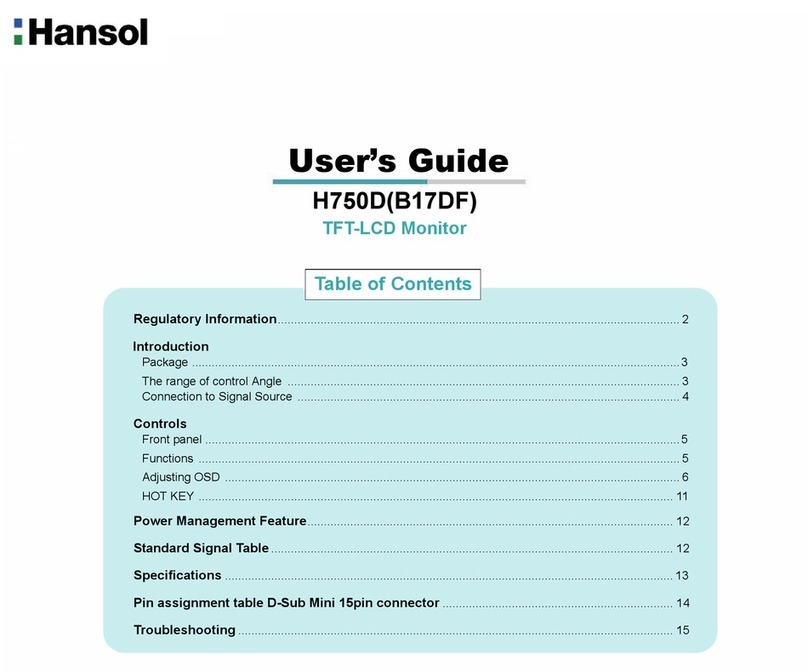
Hansol
Hansol H750D User manual
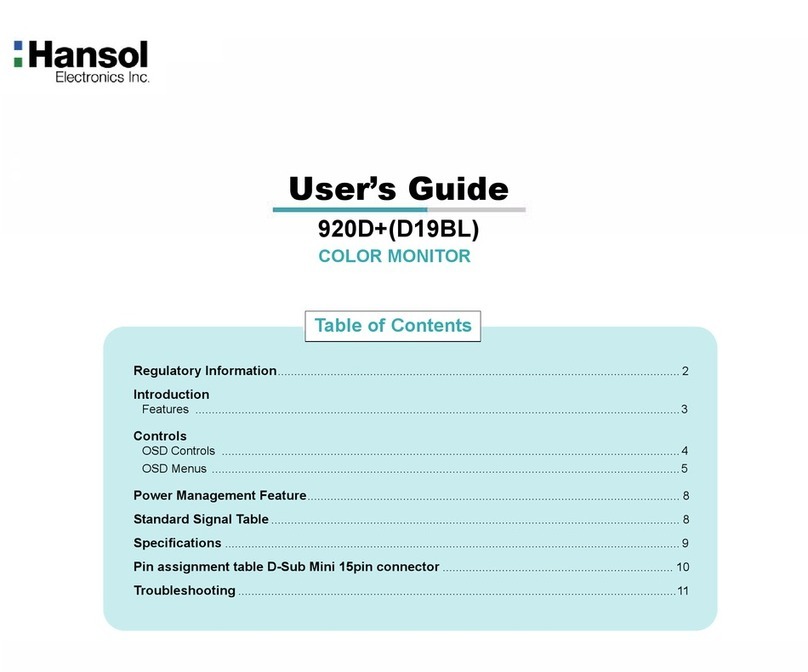
Hansol
Hansol D19BL User manual

Hansol
Hansol B15BF User manual
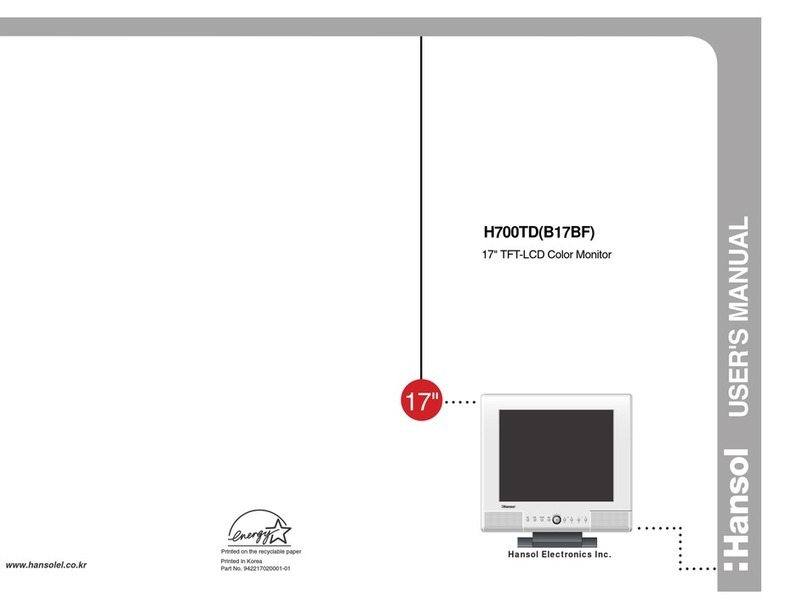
Hansol
Hansol H700TD User manual

Hansol
Hansol 19Inch (Viewable size 18 ) High Resolution Color Monitor... User manual
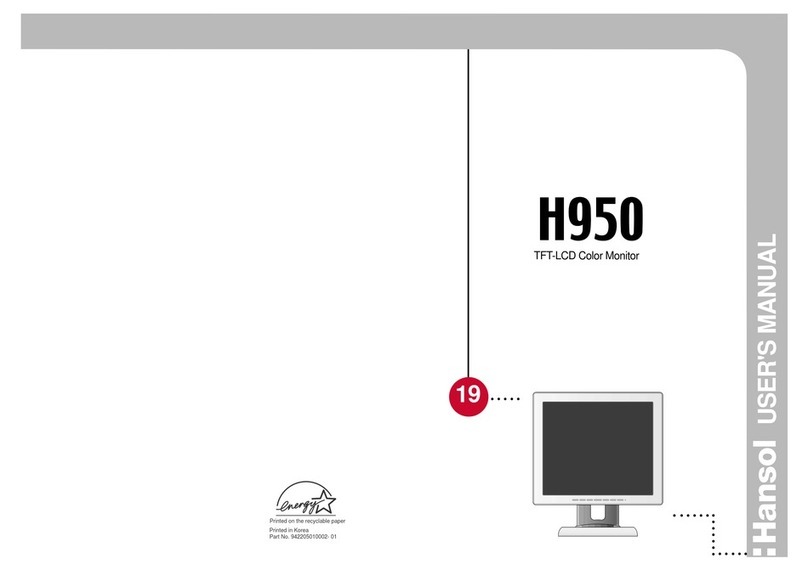
Hansol
Hansol H950 User manual
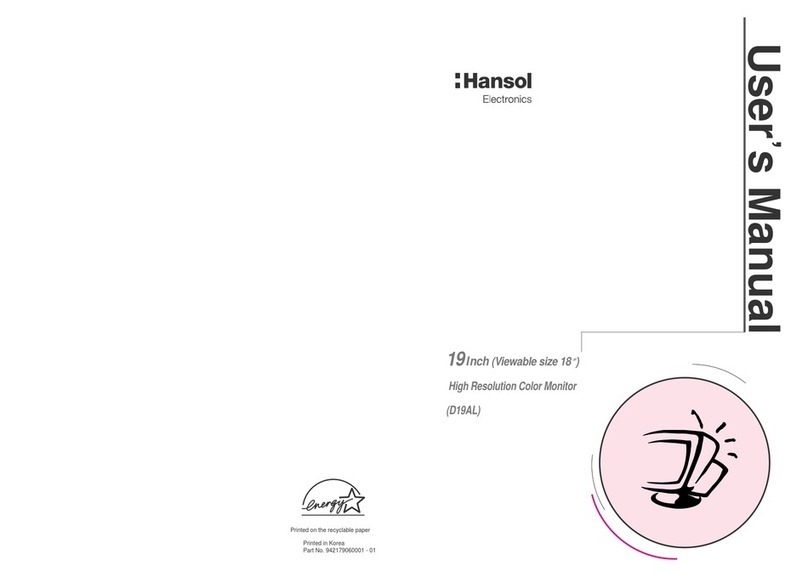
Hansol
Hansol D19AL User manual

Hansol
Hansol B19CL User manual
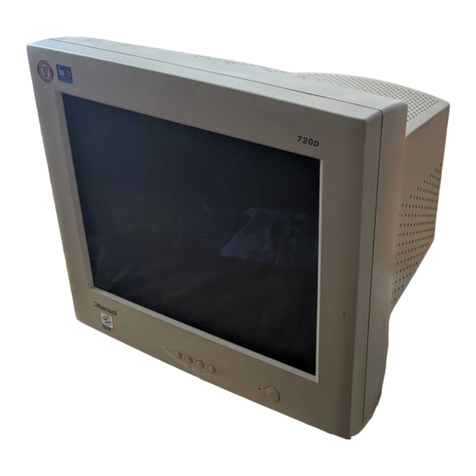
Hansol
Hansol D17DL User manual
